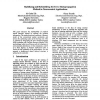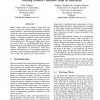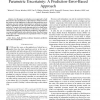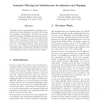ICRA
2000
IEEE
14 years 3 months ago
2000
IEEE
ICRA
2000
IEEE
14 years 3 months ago
2000
IEEE
Mobile robots require the ability to build their own maps to operate in unknown environments. A fundamental problem is that odometry-based dead reckoning cannot be used to assign ...
ICRA
2000
IEEE
14 years 3 months ago
2000
IEEE
Several kinematic control algorithms for redundant manipulators adopt generalized inverse matrices. In this line of thought, the generalized inverse control scheme is tested throu...
ICRA
2000
IEEE
14 years 3 months ago
2000
IEEE
We are exploring techniques for animation authoring and editing using a haptic force-feedback device. In our system, a family of animations is encoded by a bundle of trajectories....
ICRA
2000
IEEE
14 years 3 months ago
2000
IEEE
—In this paper, we introduce a new approach to fault detection for robot manipulators. The technique, which is based on the isolation of fault signatures via filtered torque pred...
ICRA
2000
IEEE
14 years 3 months ago
2000
IEEE
During teleoperation, a human operator often receives only 2-D visual feedback from the remote environment. While a variety of kinematic sensors exist on the remote manipulator fo...
ICRA
2000
IEEE
14 years 3 months ago
2000
IEEE
This paper presents an algorithm for simultaneous localization and map building for a mobile robot moving in an unknown environment. The robot can measure only the bearings to ide...
ICRA
2000
IEEE
14 years 3 months ago
2000
IEEE
This paper addresses the following inspection problem: given a known workspace and a robot with vision capabilities compute a short path path for the robot such that each point on...
ICRA
2000
IEEE
14 years 3 months ago
2000
IEEE
Architectures form the backbone of complete robotic systems. The right choice of architecture can go a long way in facilitating the specification, implementation and validation of...
ICRA
2000
IEEE
14 years 3 months ago
2000
IEEE
In this paper, a nonhonolonomic vehicle is stabilized to a desired pose through a wisual servoing technique. The vision-based regulation of the nonholonomic vehicle, we propose, i...




